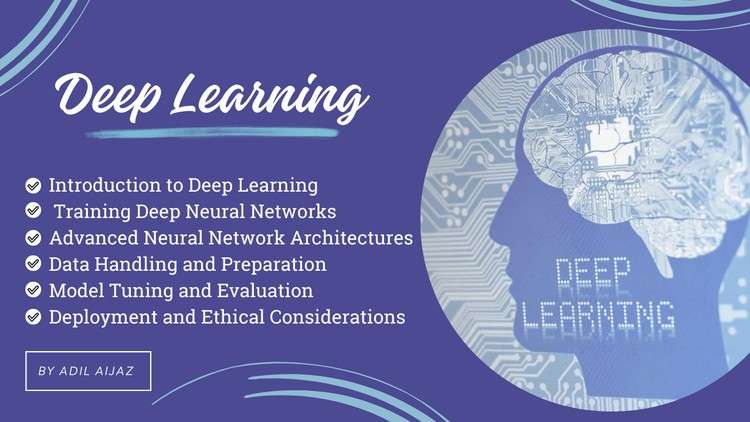
Comprehensive Deep Learning Challenge: Test Your Knowledge with Practice Questions
What you will learn
Understand the basics of deep learning and how it differs from traditional machine learning.
Learn how neural networks are structured and how they function.
Gain knowledge on how to prepare data, optimize models, and avoid overfitting.
Explore advanced models like CNNs, RNNs, GANs, and autoencoders.
Learn best practices for collecting, cleaning, and augmenting data for deep learning.
Understand how to fine-tune models and evaluate their performance using various metrics.
Learn how to deploy models into real-world environments effectively.
Explore the ethical implications of using AI, including fairness, bias, and data privacy.
Apply what you’ve learned to solve real-world problems using deep learning techniques.
Why take this course?
1. Introduction to Deep Learning
- Overview of Deep Learning: Understanding what deep learning is and how it differs from traditional machine learning.
- Neural Networks: Basics of how neural networks work, including neurons, layers, and activation functions.
- Deep Learning Frameworks: Introduction to popular frameworks like TensorFlow and PyTorch that are used to build and train deep learning models.
2. Training Deep Neural Networks
- Data Preparation: Techniques for preparing data for training, including normalization and splitting datasets.
- Optimization Techniques: Methods to improve model performance, such as gradient descent and backpropagation.
- Loss Functions: How to choose and implement loss functions to guide the training process.
- Overfitting and Regularization: Strategies to prevent models from overfitting, such as dropout and data augmentation.
3. Advanced Neural Network Architectures
Note➛ Make sure your 𝐔𝐝𝐞𝐦𝐲 cart has only this course you're going to enroll it now, Remove all other courses from the 𝐔𝐝𝐞𝐦𝐲 cart before Enrolling!
- Convolutional Neural Networks (CNNs): Used for image processing tasks, understanding the architecture and applications of CNNs.
- Recurrent Neural Networks (RNNs): Used for sequence data like text and time series, exploring RNNs and their variants like LSTM and GRU.
- Generative Adversarial Networks (GANs): Understanding how GANs work and their use in generating synthetic data.
- Autoencoders: Techniques for unsupervised learning, including dimensionality reduction and anomaly detection.
4. Data Handling and Preparation
- Data Collection: Methods for gathering data, including handling missing data and data augmentation.
- Feature Engineering: Techniques to create meaningful features from raw data that improve model performance.
- Data Augmentation: Expanding your dataset with transformations like rotation and flipping for image data.
- Data Pipelines: Setting up automated processes to clean, transform, and load data for training.
5. Model Tuning and Evaluation
- Hyperparameter Tuning: Techniques to optimize model parameters like learning rate and batch size for better performance.
- Model Evaluation Metrics: Using metrics like accuracy, precision, recall, and F1 Score to evaluate model performance.
- Cross-Validation: Ensuring that models generalize well to unseen data by using techniques like k-fold cross-validation.
- Model Validation and Testing: Strategies for validating and testing models to ensure they perform well on new data.
6. Deployment and Ethical Considerations
- Model Deployment: How to deploy models into production, including the use of APIs and cloud services.
- Ethical AI: Addressing issues like bias, fairness, and data privacy in AI systems.
- Monitoring Deployed Models: Techniques to monitor models after deployment to ensure they continue to perform well.
- Compliance and Regulations: Understanding the legal and ethical implications of using AI, including GDPR and other regulations.
English
language
Found It Free? Share It Fast!